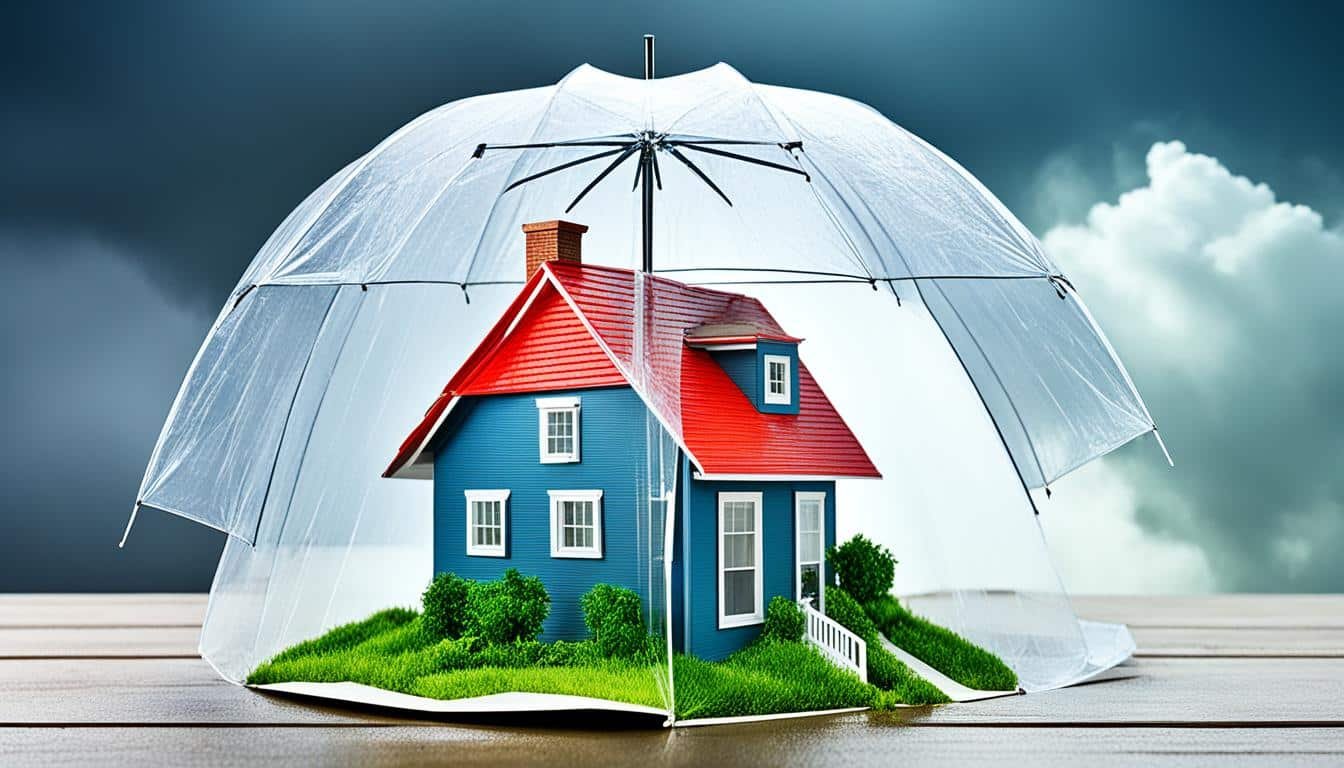When it comes to safeguarding your most valuable asset, your home, having the right home insurance coverage is crucial. Homeowners insurance provides the financial protection you need against a variety of risks, including natural disasters, theft, and accidents. With the right policy in place, you can rest assured that your property, personal belongings, and liability are covered, giving you peace of mind.
Standard homeowners insurance policies typically include four key types of coverage: protection for the structure of your home, coverage for your personal belongings, liability protection, and additional living expenses. These coverages work together to provide comprehensive protection for your home and your financial wellbeing. Whether you’re a homeowner or a renter, understanding the different insurance coverage options available can help you make an informed decision and ensure you have the right level of protection.
In addition to the core coverages, homeowners insurance policies may also offer a range of optional add-ons and endorsements, allowing you to customize your coverage to suit your specific needs. From flood insurance and liability coverage to replacement cost protection, the ability to get a quote and explore insurance policies that provide coverage tailored to your situation can be invaluable.
Whether you’re protecting your home from unexpected covered losses, seeking insurance quotes and discounts, or simply looking to understand the insurance coverage options available, this guide will provide you with the information you need to make informed decisions about your home insurance needs.
Key Takeaways
- Home insurance provides comprehensive coverage for the structure of your home, your personal belongings, liability protection, and additional living expenses.
- Homeowners insurance policies can be customized with various coverage options and endorsements to meet your specific needs.
- Comparing quotes from multiple insurance providers and exploring available discounts can help you find the best coverage at the most competitive price.
- Understanding the policy details, including coverage limits and exclusions, is crucial to ensuring you have the right level of protection for your home and assets.
- Homeowners insurance is typically required by lenders when financing a home, but it may not be legally required if you own your home outright.
Understanding Your Homeowner’s Insurance Policy
Your homeowners insurance policy is a contract between you and your insurance company that specifies what the company agrees to do in exchange for the premium you pay. The home insurance policy and homeowners insurance policy have two main sections: the declarations page and the policy itself.
The Declarations Page
The declarations page includes basic details of the agreement such as the name of the insurance company, the policyholder’s name, the location of the insured property, the policy number, the coverages purchased, the limits of liability, applicable deductibles, and the policy premium amount.
The Policy
The policy itself includes the insuring agreements, definitions, and conditions that apply to the property coverages, liability coverage, and medical coverage provided. Homeowners insurance policies generally provide coverage for the structure of the home, the policyholder’s personal belongings, liability protection, and additional living expenses if the home becomes uninhabitable due to a covered loss. The policy will specify the policy limits, deductibles, and any policy exclusions.
home insurance Eligibility

While
is not required by law, it’s important to understand the eligibility requirements and financing considerations when it comes to protecting your property. Let’s explore the details.
Do I Have to Carry Insurance on a Home?
In many states, such as Michigan, the law defines an “eligible person” for as the owner living in or a tenant of a house, condominium unit, cooperative unit, room, apartment, or a multiple unit dwelling of not more than four residential units. However, you may be considered “ineligible” and denied insurance if you have a history of arson, fraud, or non-payment of premiums, if the property is used for illegal or dangerous purposes, if taxes on the property are past due, or if the property does not meet the minimum requirements for the type of policy. If you are ineligible, you may be able to obtain coverage through state-sponsored insurance programs like the Michigan Basic Property Insurance Association (MBPIA).
While is not required by law, if you are financing your home, your lender will typically require you to purchase insurance to protect its financial interest. The lender may place “force-placed insurance” on the property and charge you for the coverage if you fail to maintain the required . If you own your home outright, you may choose not to purchase , but you will be responsible for the full cost of replacing your home and possessions if they are damaged or destroyed.
Types of Home Insurance Policies

Homeowners insurance policies come in various forms, each designed to cater to different property ownership situations and coverage needs. Understanding the key differences between these policy types can help you select the most appropriate coverage for your home and belongings.
Broad (HO-2) Policies
Broad (HO-2) policies are a basic form of homeowners insurance that cover damage to the dwelling and personal possessions from a specific list of named perils. These perils typically include fire, lightning, windstorm, hail, explosion, riot, theft, vandalism, smoke, and damage from vehicles or aircraft. While not as comprehensive as all-risk policies, HO-2 policies can provide essential protection at a lower premium.
All Risk (HO-3) Policies
All Risk (HO-3) policies are the most common type of homeowners insurance. These policies provide coverage for the dwelling against all risks or perils, except for those explicitly excluded in the policy. Meanwhile, the home’s contents are generally covered against named perils, such as fire, theft, and vandalism. HO-3 policies offer broader protection than HO-2 policies, making them a popular choice for many homeowners.
Renters (HO-4) Policies
Renters (HO-4) policies are designed for individuals who do not own the property they occupy. These policies provide coverage for the renter’s personal property, such as furniture, clothing, and electronics, if they are stolen, damaged, or destroyed. However, renters policies do not cover the dwelling or any detached structures, as those are the responsibility of the property owner.
Condominium (HO-6) Policies
Condominium (HO-6) policies are tailored for condo owners, providing coverage for the owner’s personal property as well as the portion of the dwelling that belongs to the condominium unit. These policies typically cover both the contents and the structure against named perils, ensuring comprehensive protection for condo residents.
Homeowners insurance policies can be further customized with endorsements, floaters, or riders to provide additional coverage for specific items or risks, such as jewelry, fine art, or natural disasters. Discussing your coverage needs with an insurance agent can help you determine the most suitable policy type and enhancements for your unique situation.
Settlement Options for Home Insurance Claims

When it comes to home insurance coverage, it’s essential to understand the differences between replacement cost, repair cost, and actual cash value. These settlement options can significantly impact the amount you receive for a covered loss.
Replacement Cost
Replacement cost coverage pays the full cost of replacing, repairing, or rebuilding your home to its original condition, using materials of the same kind and quality, minus your deductible and up to the policy’s dollar limit. This ensures your home can be restored to its pre-loss state, providing you with the resources to rebuild your home without having to worry about depreciation.
Repair Cost
Repair cost coverage pays to replace, repair, or rebuild your damaged dwelling to a similar condition, using contemporary materials. However, the maximum amount the insurer will pay may not be enough to fully restore the property to its original condition. This can leave you responsible for the difference in home repair costs, so it’s important to consider your policy limits.
| Settlement Option | What it Covers | Considerations |
|---|---|---|
| Replacement Cost | Full cost to replace, repair, or rebuild to original condition | Pays up to policy limits, minus deductible |
| Repair Cost | Replacement with similar, contemporary materials | May not cover full cost to restore property to original state |
| Actual Cash Value | Replacement cost minus depreciation | Provides less coverage than replacement or repair cost |
Discussing these policy coverage options with your insurance agent can help ensure you have the appropriate level of home insurance claim settlement protection for your needs, whether it’s replacement cost coverage, repair cost coverage, or actual cash value. Understanding these distinctions can give you the confidence that your home and assets are properly protected in the event of a covered home rebuild or home repair scenario.
Coverage for the Structure of Your Home

Homeowners coverage provides financial protection for the home structure coverage of your residence. Your dwelling protection policy pays to repair or rebuild your home if it is damaged or destroyed by covered perils like fire, hurricane, hail, or lightning. Most policies also cover detached structures like a garage or shed, generally for about 10% of the amount of insurance on the house itself. However, standard homeowners policies do not provide coverage for damage caused by a excluded perils such as flood, earthquake, or normal wear and tear.
When purchasing coverage for the structure of your home, it’s crucial to have enough protection to fully rebuild your home in the event of a total loss. This ensures you can restore your property to its pre-loss condition, safeguarding your investment and providing peace of mind.
Coverage for Your Personal Belongings

Homeowners insurance also provides valuable coverage for your personal belongings, such as furniture, clothing, and sports equipment, in the event they are stolen or damaged by a covered peril. This personal property coverage is typically 50-70% of the amount of insurance on the structure of your home. To ensure you have adequate contents coverage, it’s a good idea to conduct a thorough home inventory, cataloging your possessions and their approximate value.
Expensive Items Coverage
Your homeowners policy also extends protection to high-value items like jewelry, furs, art, and collectibles. However, there may be dollar limits on the amount the insurance company will pay out if these expensive belongings are stolen. To fully insure your most valuable personal possessions, you can purchase special coverage endorsements or floaters that provide coverage up to their full replacement cost or actual cash value.
Trees, Plants, and Shrubs Coverage
The landscaping around your home is also covered under your homeowners insurance, up to around $500 per item for trees, plants, and shrubs. This coverage protects against damage or destruction caused by covered perils, though it does not extend to losses resulting from disease or poor maintenance. Keeping a detailed home inventory of your outdoor plantings can help ensure you receive the appropriate compensation in the event of a claim.
Liability Protection

Liability coverage in a homeowners insurance policy protects you against lawsuits for bodily injury or property damage that you or your family members cause to others. It pays for both the cost of defending you in court and any court awards, up to the limit stated in your policy. Liability limits generally start at around $100,000, but it’s a good idea to discuss increasing the liability coverage with your insurance agent, especially if you have significant assets. For broader liability protection, you may also want to consider purchasing an umbrella policy or excess liability coverage.
Liability Limits
Your homeowners insurance policy provides personal liability coverage to protect you from claims of bodily injury or property damage caused by you or your family members. It’s important to review your liability limits to ensure you have adequate coverage, especially if you have significant assets or engage in activities that could potentially lead to lawsuits.
No-Fault Medical Coverage
The homeowners policy also includes medical payments coverage, which pays the medical bills of guests or others who are injured on your property, without a liability claim being filed against you. This coverage is separate from your family’s own medical expenses, providing an additional layer of protection for your home and visitors.
Additional Living Expenses (ALE)

When your home becomes uninhabitable due to a covered disaster, your homeowners insurance policy’s additional living expenses (ALE) coverage can help pay for the extra costs of living elsewhere. This coverage can cover expenses like hotel bills, restaurant meals, and other costs that exceed your usual living expenses while your home is being repaired or rebuilt.
ALE coverage comes with its own policy limits, both in terms of the dollar amount and the time period it will provide benefits. However, these ALE limits are separate from the amount available to rebuild your home. Even if you exhaust your ALE coverage, the insurance company will still pay the full cost of rebuilding your home up to the policy limits.
If you rent out part of your home, your ALE coverage can also pay for the rent you would have collected from a tenant if the home was destroyed by a covered peril. This can help offset the rental income you lose while your home is being repaired or rebuilt.
Understanding the details of your ALE coverage, including the dollar limits and time limitations, is important when filing a claim and ensuring you have the financial support you need during the recovery process. Discuss these specifics with your insurance agent to ensure you have the appropriate level of temporary housing and additional living expenses coverage for your situation.
Shopping for Home Insurance Coverage

When researching
home insurance quotes
, it’s crucial to compare offerings from multiple
insurance providers
. This allows you to find the most comprehensive
home insurance policy
at the best possible price. As you review
policy details
, pay close attention to coverage limits, deductibles, and any additional
coverage options
that may be worth adding to customize your protection.
Comparing Quotes
Comparing home insurance quotes is the best way to ensure you secure the right coverage at a competitive rate. Take the time to request quotes from several reputable insurers, carefully reviewing the specifics of each policy. Pay close attention to the policy limits and deductibles to understand your out-of-pocket costs in the event of a claim.
Discounts and Savings Opportunities
Many insurance companies offer a variety of home insurance discounts and savings opportunities to help lower your annual premium. These may include discounts for bundling your home and auto insurance, installing security systems, or maintaining a claims-free history. Be sure to discuss all potential home insurance savings with your agent to ensure you maximize your coverage while minimizing costs.
Filing a Home Insurance Claim

If you experience a
home insurance claim
that is covered by your homeowners insurance policy, the next step is to file a
claim with your insurance company
. This process involves
documenting the damage or loss
, providing evidence, and working closely with the
insurance company
to settle the
claim
.
Documenting the Loss
Be sure to keep detailed records and receipts related to the loss, as well as any communication with the insurance company. This documentation will help support your claim and ensure the claim settlement accurately reflects the extent of the damage or loss.
Working with the Insurance Company
The insurance company will review the claim and determine the appropriate settlement based on your policy coverage. If you have any issues or disputes, you may need to escalate the matter with the insurance company or file a complaint with the state insurance department to ensure a fair claim payment or claim denial resolution.
| Key Steps for Filing a Home Insurance Claim | Details |
|---|---|
| Documenting the Loss |
|
| Working with the Insurance Company |
|
insurance company
, you can help ensure a smooth and successful
home insurance claim
process, protecting your property and financial wellbeing.
Also Read : Navigating Insurance Claim Settlement Smoothly
Conclusion
Home insurance provides comprehensive coverage to protect your home, personal belongings, and liability from a variety of covered losses. By understanding the different types of home insurance policies, coverage options, and claim settlement procedures, you can ensure your home and assets are properly protected.
When shopping for home insurance, compare quotes, explore available discounts, and work closely with your insurance agent to customize a policy that meets your unique needs. Filing a claim and working with the insurance company can be an important part of the process, so be prepared to document your losses and navigate the claim settlement.
With the right home insurance coverage in place, you can have peace of mind knowing your property and financial wellbeing are safeguarded. By taking the time to understand your policy protection and the claim process, you can ensure your home, personal belongings, and liability are properly covered against a variety of potential losses.
FAQs
Q: What is home insurance?
A: Home insurance is a type of insurance policy that provides coverage for your property, belongings, and liability in case of theft, damage, or disasters.
Q: How can I get a home insurance quote?
A: You can get a home insurance quote by contacting insurance agencies, visiting their websites, or using online tools to compare different plans and prices.
Q: Are there any discounts available for homeowners insurance?
A: Yes, insurance companies offer various discounts such as multi-policy discounts, security system discounts, and loyalty discounts for homeowners insurance.
Q: What does homeowners insurance coverage typically include?
A: Homeowners insurance coverage may include protection for damage to your home, personal property, liability coverage, and additional living expenses in case of a covered loss.
Q: How do I know the market value of my home for insurance purposes?
A: The market value of your home may differ from the cost to rebuild it, which is the amount typically covered by homeowners insurance. You can consult with real estate professionals or appraisers to get an estimate.
Q: What are some common questions about homeowners insurance?
A: Common questions about homeowners insurance include inquiries about coverage limits, deductibles, additional policies like flood insurance, and how to file a claim.
Q: How can I learn more about homeowners insurance?
A: You can learn more about homeowners insurance by reading available resources on insurance company websites, speaking with insurance agents, or attending informational sessions.





